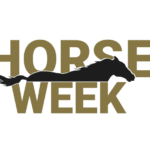[/caption]

Markopoulo, Greece, August 22, 2004–I think America could be on the way to an Olympic gold medal in show jumping. I’m usually not that optimistic, but judging from the way the U.S. team handled itself in the discipline’s first competition this morning, I think we’ve got what it takes.
“They should give out the medals today,” chuckled coach Frank Chapot. Unfortunately, they didn’t. In fact, this competition didn’t even count for the team medals. Those won’t be awarded until after a marathon session on Tuesday. This class was a qualifier for the individual medal finals on Friday when the equestrian portion of the Games ends. So we’ve got a long way to go. But all the horses and riders look fine and ready to cope with whatever they encounter on the big green rectangle of grass in the midst of an arid vista.
As John Madden put it, with an understated smile, “It’s not such a bad start, but it’s just the beginning.”
His wife, Beezie, on Authentic, and Peter Wylde on Fein Cera were among 10 riders in the field of 76 who were fault-free during the one round against the clock format. This was not really a speed class as you may be familiar with it. Rather, everyone who left the jumps up and finished within the 94-second time-allowed tied for first place.
Right behind in a six-way tie for 11th was McLain Ward on Sapphire with a single time fault. The only surprise for the U.S. was Chris Kappler who had a knockdown with Royal Kaliber at the second part of a double, three fences from the end of the course, to tie for 19th.
Germany had no one in the top group. Ludger Beerbaum, one of the favorites for the individual gold, logged just a time fault on Goldfever, as did his teammate Otto Becker with Cento.
Ludger isn’t worried about Germany’s chances though that team is here without the world’s No. 1 rider, Marcus Ehning (horse injury) and the formidable Meredith Michaels Beerbaum (a positive drug test on her horse.)
“I think that this is not a key point for the competition,” Ludger said of the opening competition. “Even with eight faults you can sleep easily.”
Course designer Olaf Petersen said he wouldn’t have minded if 15 had been clean.
“My theory is, this is not a medal class,” he said. “I wanted it to be difficult enough to sort out some, but not so much that it was impossible for the weakest ones. Time was short on purpose. I wanted to make it more galloping; then it doesn’t have to be as big.”
Indeed, the top group was an eclectic one, even including Greek Antonis Petris whose clean round aboard Gredo La Daviere was greeted with keen enthusiasm by the partisan audience.
They weren’t a horse-educated crowd — after all, there are only 3,000 riders in Greece — but they made up for that lack with their passion. When the first Greek rider, Emmanouela Athanassiades, trotted into the arena, they didn’t know that you’re not supposed to cheer for every successful jump. So it was jump/wild applause and from various portions of the stands “shhhh.” Then jump/wild applause/”shhh.” That pattern kept up until the rider had the fifth fence down, when the applause turned to “ohhhh.” After she had refusals at two fences and was eliminated, there was a mass sympathetic sigh. These folks could really get into show jumping.
They probably would have enjoyed just looking at the course even without the horses. Olaf owns a jump building business that provided the fences, which had imaginative Greek themes. There was the birdhouse jump, No. 1 on course, with standards replicating Aegean sea island buildings that house pigeons on the top floors. My favorite is the atom (that’s what Peter Wylde is jumping in the photo I took.) I didn’t understand the connection between the atom and Greece until Olaf explained that the Greek philosopher Democritus originally conceptualized the atom.
The heart of the course was the line through the center of the course that offered an option at fence 7, the amphitheater, with one side higher than the other. Then it was six strides to a two-stride Olympic logo double, 8A and B.
“Depending on how your horse had to jump forward or backward,” said Peter, “that allowed you to do the four nicely or the five nicely” to fence 9, the Greek doors.
Peter said he was lucky because “Fein Cera is incredibly rideable. She allows you to do either one very easily, so it’s just a matter of making the decision when you’re leaving the ground at B. That’s really a great course design question. It showed the degree of difficulty and the caliber of riding.”
There will be many more chances to show the caliber of riding here before it’s all over. I’m expecting a comeback from former World and World Cup Champion Rodrigo Pessoa of Brazil who had a knockdown and time fault with Baloubet du Rouet. I do, however, remember when Rodrigo seemed ready to claim his gold medal in Sydney in 2000 and Baloubet turned on the brakes. There’s nothing that says he won’t do it again, but Rodrigo is the rider to master the situation if it’s at all possible.
Others to watch out for include Nick Skelton of Great Britain (the Brits didn’t qualify to send a team, if you can believe that), who had just one fault with the impressive stallion Arko, and former world No. 1 Markus Fuchs of Switzerland on Tinka’s Boy, who also had a rail down.
We’ll see how things go on Tuesday, but I can’t help feeling that this U.S. team could redeem our show jumping fortunes. I think it’s money in the bank.
Meanwhile, I go back to dressage Monday for the Grand Prix Special. See you then!





